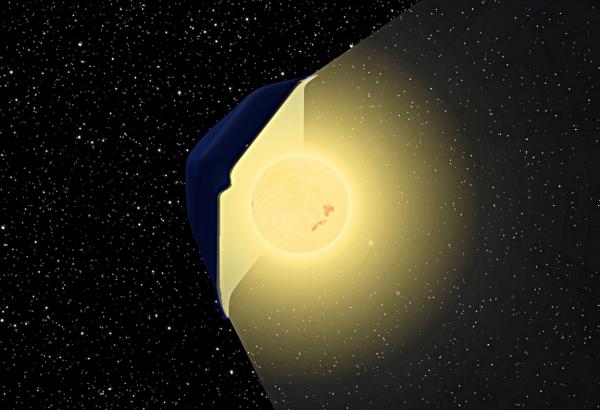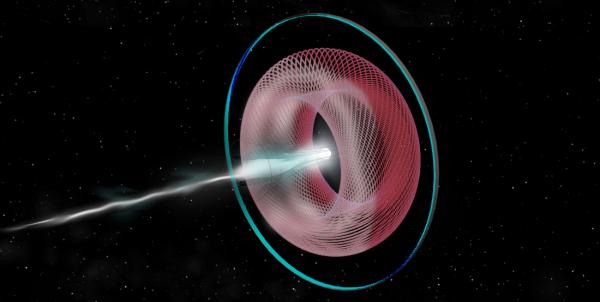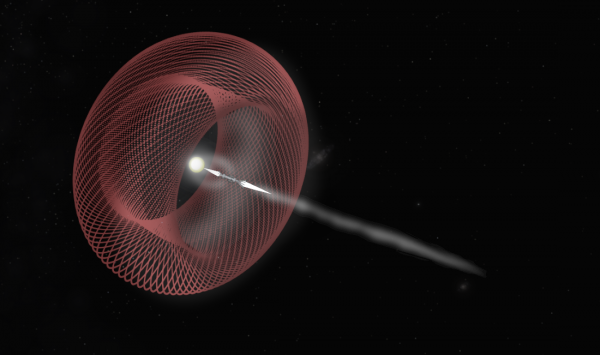BY LETTER
Stellar Propulsion Systems
Technology > Application > Megascale Engineering
Technology > Application > Transportation > Propulsion Technology
Technology > Technology Levels > Ultratech
Technology > Application > Transportation > Propulsion Technology
Technology > Technology Levels > Ultratech
Various methods of moving stars | |
 Image from Steve Bowers | |
| The Shkadov Thruster uses a massive light-reflecting megastructure as a form of gravity tug. | |
There are many types of stellar engines used to move stars, each with their own associated challenges. The luminosity of the star can be used to produced thrust, or the mass of the star can be converted into energy by fusion or conversion technology.
Shkadov Thrusters
Solar reflectors, a common technology available at all levels, are able to work at stellar scales as well. The Shkadov Thruster uses a massive, reflective, parabolic dish array placed in the direction of desired motion. The star's light pushes on the reflector array and reflects backwards, producing a small thrust. Meanwhile the dish array is bound to the star by a balanced force of gravity and radiation pressure; effectively acting as light-powered gravity tug. The reflection of the photons and the bound system between the reflectors and the sun result in a net positive force in the direction of the dish. The array is parabolic in order to direct the light backwards behind the star, and consists of less than less than half a sphere, so as not to reflect too much of the star's light back at itself. This is not a reactionless drive; the exhaust is photons.For the Shkadov thruster, the brighter a star the faster the acceleration, although it is still a slow method. Though this system is known to be in use in various locations throughout the Terragen Sphere, it can take several hundred thousand years to accelerate up to just a few meters per second. The direction of thrust is generally limited within relatively perpendicular to the plane of the solar system, otherwise anything in orbit will see periods of intense directed sunlight followed by periods of limited to zero sunlight.
The material for the dish can be mined from the sun itself or anything of the surrounding system. It must be reflective, as thin and of as little mass as possible. Material from any source is harvested and processed into thin reflective panels which are then transported to their static location awaiting integration into the larger system. From there they can either begin the thrust process alone, or rotate so as not to reflect light until larger components are ready for assembly.
Stellar Propulsion Swarm
 Image from Steve Bowers | |
| This propulsion swarm is surrounded by a ring-like habitat that will accompany the star on its travels | |
The Stellar Propulsion Swarm is a method of moving stars by using their own energy to accelerate fusion at selected points on the star's surface. Unlike the Shkadov Thruster this method uses expelled stellar material as propulsive mass, so the acceleration achieved can be many magnitudes greater.
In a Propulsion Swarm a significant fraction of the natural luminosity of the star is collected by a Dyson Swarm, usually arranged in a torus around the centre for stability. Each satellite stores this energy until its orbit takes it within line-of-sight of one chosen pole of the star; the satellite then emits the stored energy using phased-array transmitters towards that pole. This has the effect of heating that pole considerably, causing a continuous flare and mass-ejection only at one end.
The resulting mass-stream is focused and controlled by superconducting rings embedded in the swarm and attached to dynamic compression members extending behind the star. The expelled mass causes the star to accelerate in the opposite direction. All the objects in the swarm must track their distance from the star and use some energy to redirect and accelerate the solar wind to adjust their orbits to track the movement of the star.
The direction of thrust is limited to points along the rotational axis, as the heated point and matter must stay relatively stationary on the star. The application requires only a specialized dyson swarm designed for the process in order to function. Objects in orbit around the star will be brought along for the trip.
The Caplan Thruster
 Image from Steve Bowers | |
| The Caplan Thruster system uses a propulsion swarm coupled with a fusion (or conversion drive) candle | |
The Stellar Propulsion swarm, the Caplan thruster and related designs can potentially move a star light years on the timescale of tens of thousands of years. This process has the additional benefit of potentially extending a stars lifespan due to the reduction of mass, and the amount of mass actually necessary to move a given star is relatively low compared to the mass of the star itself. Propulsion swarms and Caplan Thrusters are in use in several Sephirotic systems, and elsewhere in the Terragen Sphere, especially in the Panvirtuality metaempire.
---------------------
There are further theorized methods of moving stars, utilizing technology not yet fully understood by modosophont technology. Observations of distant galaxies have revealed many locations where stars and other large objects have been, or are being, actively moved by xenosophont civilisations. The Sundrivers, for instance are an alien civilization in the Virgo cluster which are known only by the erratic motion of stars within a certain region, believed to be powered by some form of reactionless drive.
Related Articles
- Dyson Swarm, Dyson Sphere
- Gravity Tug
- Star Lifting
- Stellar Engineering - Text by M. Alan Kazlev
Modifying or customizing a star in any manner. Could be for the purposes of stellar husbandry, or for more exotic purposes. - Stellar Husbandry
- Superconductors
Appears in Topics
Development Notes
Text by Alex Mulvey, Andrew Broeker
Additional material by Steve Bowers
Initially published on 29 April 2009.
Amended 2/ 2021
The Stellar Propulsion swarm is adapted from an idea by Alex Tolley, posted at Centauri Dreams.
also inspired by the Bowl of Heaven, a fictional construct devised by Larry Niven and Gregory Benford
Swarm configuration derived by Bob Jenkins
Additional material by Steve Bowers
Initially published on 29 April 2009.
Amended 2/ 2021
The Stellar Propulsion swarm is adapted from an idea by Alex Tolley, posted at Centauri Dreams.
also inspired by the Bowl of Heaven, a fictional construct devised by Larry Niven and Gregory Benford
Swarm configuration derived by Bob Jenkins
Additional Information
Equations for the thrust in a Shkadov Thruster system, and an explanation of the symbols used.






